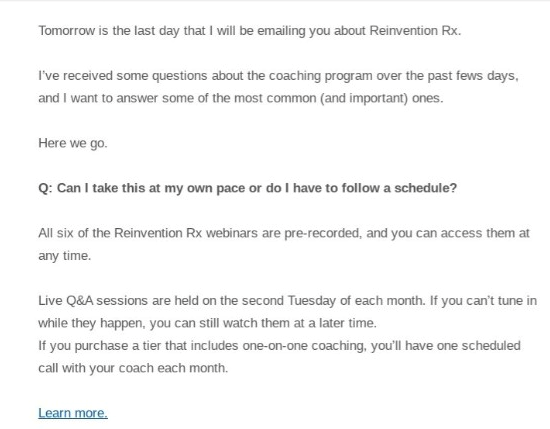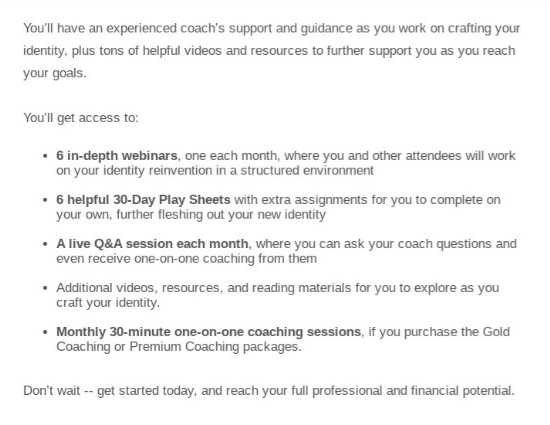So you have an online course. Maybe it’s brand new and just released, or maybe you’ve had it up for a while. Either way, you need to sell it. And that’s honestly the hardest part.
An email series is a great way to start making some sales with this kind of info product. We recently did this successfully for a client of ours at RankReset.
We’re sharing our process with you, so you can implement it for yourself. This is a clear-cut email series with a very specific structure. You can adapt it to just about any course, and start making some sales within the next couple of weeks.
Content:
- How to market online courses and skyrocket your sales with five simple emails
- Who should use this five-email flow to promote online courses?
- Course creators with an offering priced at $399 or less
- People who want to sell courses now
- People who want to sell courses in the future
- What do you need to make an email flow promoting your online course work?
- Trust
- A clear offer
- The confidence to sell hard when it’s time
- Email flow to promote an online course in detail
- The structure and timetable
- Email 1. Pure education and helpful information
- Email 2. More helpful education and actionable advice
- Email 3. From education to intro pitch: easing into the course
- Email 4. Starting the hard sell: sales pitch and course FAQ
- Email 5. Driving home the value with a case study, and finishing off with a strong CTA
- Conclusion
How to market online courses and skyrocket your sales with five simple emails
Here’s an overview of the emails we used to promote an online course, and when we sent them.
Email 1. Purely educational. Sent on Monday at 9 a.m.
Email 2. More helpful and actionable advice. Sent on Thursday at 9 a.m.
Email 3. Transition from education to pitch. Sent the following Monday at 9 a.m.
Email 4. Sales pitch and course FAQ. Sent on Wednesday at 9 a.m.
Email 5. Case study and a strong CTA. Sent on Friday at 9 a.m.
Sent out over a two-week period, this series of emails is carefully designed to hook your readers, then gradually introduce your course. By the time you hit the sales pitch, they’re already primed and interested, so making the sale is a breeze.
Who should use this five-email flow to promote online courses?
This email flow is designed to be super effective for courses at a price point under $399.
More expensive courses may require a longer timetable to really nurture your prospects and convince them it’s worth the money. But if you have a solid course priced under $400, with a clear offer and concrete benefits for the students who take it, then this email flow is a great way to sell it.
Here’s who can benefit the most from using this email flow to market an online course.
Course creators with an offering priced at $399 or less
The length and structure of this series was designed for an online course called Reinvention Rx, and it has three price tiers, the most expensive of which was priced at $399.
The other two tiers are priced at $49 and $229, respectively.

It’s meant to nurture its audience toward a purchase at that kind of price point. For more expensive courses, you may need a longer email flow or a set of flows.
The more you charge, the more time it will take to convince people that your course is worth the money. This series consists of five emails over a two week period, which might not be enough to convince someone to spend a larger amount. The sales cycle for pricier courses is probably going to be longer and more complex.
People who want to sell courses now
Got a new course you’ve just released? Want to start making some sales ASAP? Then this series is for you. It also works if you’ve had your course available for a while, but you’ve had trouble making sales.
It’s designed to be a quick way to drive some sales, over a couple of weeks after you have created your course using an online course platform. When done right, you can start seeing some course sales roll in fast once you reach the pitching stage of the series.
People who want to sell courses in the future
If you already have a list, you’re ahead of the game. If not, you can still plan this series out as an evergreen part of your email marketing funnel.
If you don’t have a list yet, there’s no better time than now to start gathering one.
You can start building your mailing list by adding a subscription form to your website. This works best if you offer people something in exchange for giving you their email address. This could be a discount on a product, helpful information in the form of an eBook or white paper, or anything else you can think of that would be valuable to your audience.
As you bring in new subscribers, you can set up your email marketing software to send them the series automatically. You can also segment your list, once you’ve started building one, to target this series to a more specific group of people.
So if you’ve got a course to sell, but you haven’t built a list yet, you can start planning to put a series like this together once you have people to send it to.
What do you need to make an email flow promoting your online course work?
At this stage we are going to assume that you have an existing course that both provides real value to your students and you have the ability to handle an influx of new students.
With that being said, here are the three things that will make this email flow promoting an online course really work for you.
Trust
The series we’re talking about works best when you’ve already begun to cultivate trust with your email subscribers, using strategies like content marketing to demonstrate your authority and expertise.
We recommend implementing this email flow at a point where you’ve already begun building up a credible brand, as well as a targeted audience following.
It works best when sent to an audience that already trusts you as a thought leader in your niche. Its effectiveness relies on your brand being positioned as an authority — someone who really knows what they’re talking about.
Content marketing is an excellent way to cultivate this kind of authority and trust for your brand. By answering questions that your audience has, and giving them the information they need and want, you can inspire them to look up to you as an authority in your space.
So if you’ve got a solid following who keeps coming back for your content, and your brand is starting to get a solid reputation, you’re in a great position to leverage this email strategy to market your online course.
The first two emails, plus the first half of the third email, are designed to highlight and reinforce this existing audience’s trust before you even mention the course.
A clear offer
Offer clarity is key. It needs to be immediately obvious not only what your course entails, but what concrete and tangible benefits students can get from it.

People care most about results — especially when you’re asking them to get their credit card out.
This was the biggest challenge with Soul Salt’s Reinvention Rx course, the course for which we created this email series. The course is designed to walk students through the process of figuring out how to reinvent their professional identity, from figuring out who they want to be, to making the career changes necessary to make it happen.
Prior to creating these emails, we’d written and published a new and improved sales page for it, with a clear description of what the course is, what it does, and why you should buy it.
For this series to work, you need a clear offer. It needs to be apparent what your course can do for people — in terms of tangible, concrete benefits. The educational part of the series gives you an opportunity to give readers a sample of this, providing relevant information and actionable advice for free before you pitch them anything.
The confidence to sell hard when it’s time
Don’t be afraid to push for a sale. By the time you get to that point in the series — emails 4 and 5 — you’ll have already laid a lot of groundwork to prime your audience to be receptive to the sales pitch.

Don’t feel like you’re being overbearing or intrusive. It’s okay to go for a hard sales pitch at the end. By the time you get there, you’ll have earned the ability to do that effectively, by providing so much value upfront.
Email flow to promote an online course in detail
We sent it out to subscribers over a two week period and used effective email copy to draw them into our offer. The first week was used to state the problem our course solved and to get our subscribers thinking about our solution.
This then paved the way perfectly for us to move into the course offer the following week, without the offer coming completely out of left field.
The structure and timetable
Here’s a recap of the general structure of the series we used:
- Monday: Purely educational.
- Thursday: More helpful and actionable advice.
- Monday: Transition from education to pitch.
- Wednesday: Sales pitch and course FAQ.
- Friday: Case study and a strong CTA.
Email 1. Pure education and helpful information
We started slow, with a purely educational and informational approach. This went out on a Monday during the first week of the two-week series schedule.
There’s no sales pitch here. In fact, we didn’t even mention the course at all in the first email. Instead, we introduced the topic the course is about: career reinvention. Because it made a lot of sense to do so, we opened by tying it into current events — specifically, the massive changes being brought into the working world by the COVID-19 pandemic.
We talked about how career reinvention can help you adapt to a changing world, offering some helpful advice on how to start approaching the idea and thinking about whether you might be ready for that kind of change.

The key here is the education-only approach. You don’t even need to mention your course yet.
Email 2. More helpful education and actionable advice
Email 2 was sent out on Thursday, three days after the first email. This email continues to provide education and advice — specifically, a set of actionable steps that readers can act on as soon as they’d like.
First, we really drove home the message of the value of career reinvention. Then, we offered a set of concrete steps that people can use to get started with the process — namely, instructions for how to identify their biggest core values.

At the end, in a PS section, we tease the course. It’s the very first mention of it in the series — at this point, as just a quick addendum.

Email 3. From education to intro pitch: easing into the course
Email 3 is where we actually transitioned into the course itself.
After providing some more helpful education about career reinvention in the first half of the email, we moved into the introduction of the actual course in the second half. The educational part talked about the actual anatomy of the reinvention process, framed as a clear set of steps.

It’s not an easy process to go through — a fact which led us naturally into an intro pitch for the course. The intro pitch details exactly what the course offers, what it does for you, and what you’ll learn from it.

This is the inflection point where we’re really getting into the sales-heavy part of the series. The focus is now 100% on pitching the course.
Because you’ve laid the groundwork with the informational emails, your readers are well primed to be receptive to your offer. But, we’re not done yet. We still have two emails to go, both much more sales-heavy.
Email 4. Starting the hard sell: sales pitch and course FAQ
For Email 4, sent out Wednesday of Week 2, we decided to frame the message as a set of Frequently Asked Questions.

The goal was to further clarify the offer, by answering some of the most common questions people generally had about it.
At this point in the series, it needs to be increasingly clear exactly what the value is that you’re selling. A detailed FAQ is a great way to do that, especially if your course is something relatively complex or multifaceted.
Email 5. Driving home the value with a case study, and finishing off with a strong CTA
What better way to demonstrate the benefits of your course than a case study of a successful previous student? It’s worth mentioning that if your course is brand new, you might not have this yet. But, if you have something pretty close, you can use that instead.
The case study we used revolved around someone the course instructor had coached privately in the past, using the exact same techniques she uses in her course.

If your course has been around for a while, and you already have previous students, try reaching out to them and asking about their success. You can also work with any existing student testimonials that you have.
If you have any hard numbers or statistics available, use them here.
Following the case study is a quick recap of exactly what the course offers. In our case, it was a set of webinars, Q&A sessions, and additional worksheet materials.

The more concrete and specific you can be here, the better.
Conclusion
This simple five-email series, sent out to list subscribers over a two-week period, is a great way to promote your online course and start seeing some sales roll in for it.
Whether your course is brand new, or it’s been around for a while, you can leverage this email series to start bringing in some sales sooner rather than later. It works as an initial promotion for new courses, as well as working as an evergreen series you can send out to new subscribers.
You have an awesome course that can help a lot of people. It’s just a matter of letting them know it exists. So go out there and start making some sales.
At RankReset, we work with online course creators to promote the courses that they’ve worked so hard to create. Using a combination of search engine optimization (SEO), smart content strategy, and email marketing, we help online course creators make more sales than ever before.








